RAF Wittering
| RAF Wittering | |||||||
|---|---|---|---|---|---|---|---|
| Near Wittering, Cambridgeshire in England | |||||||
 | |||||||
 EGXT Shown within Cambridgeshire | |||||||
| Coordinates | 52°36′45″N 000°28′35″W / 52.61250°N 0.47639°WCoordinates: 52°36′45″N 000°28′35″W / 52.61250°N 0.47639°W | ||||||
| Type | Royal Air Force station | ||||||
| Site information | |||||||
| Owner | Ministry of Defence | ||||||
| Operator | Royal Air Force | ||||||
| Site history | |||||||
| Built | 5 May 1916 | ||||||
| In use | 1916-Present | ||||||
| Garrison information | |||||||
| Current commander | Group Captain Rich Pratley ADC MA* MSC BA(Hons) RAF.[1] | ||||||
| Airfield information | |||||||
| Identifiers | ICAO: EGXT | ||||||
| Elevation | 83 metres (272 ft) AMSL | ||||||
| |||||||
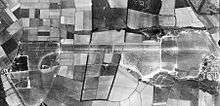
Royal Air Force Station Wittering or more simply RAF Wittering (ICAO: EGXT) is a Royal Air Force station within the unitary authority area of Peterborough, Cambridgeshire. Although Stamford in Lincolnshire is the nearest town, the runways of RAF Wittering cross the boundary between Cambridgeshire and Northamptonshire.
Current use
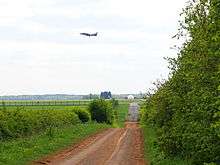
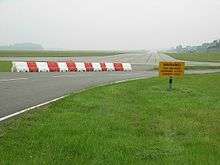
The station is the home of the 'A4 Force'[2] (the Royal Air Force's engineering and logistic Air Combat Service Support Units (ACSSUs)), with No. 85 (Expeditionary Logistics) Wing RAF and its subordinate ACSSUs, 2 MT Squadron and 3 Mobile Catering Squadron (formerly the Mobile Catering Support Unit (MCSU)) moving in from RAF Stafford. Elements of the Armament Support Unit (ASU) also returned to RAF Wittering from RAF Marham in Norfolk to be part of the newly formed No. 42 (Expeditionary Support) Wing RAF, which also took 5001 Squadron under command from 85 Wing when that unit also relocated from RAF Stafford. In 2016 the Ministry of Defence confirmed that the Station would one the the RAF's 'well found centres of specialisation for' 'Support Enablers' along with RAF Leeming.[3]
In addition to the A4 Force Elements, RAF Wittering support a wide variety of 'lodger' units located on the station.
In November 2011 the Ministry of Defence announced that 44 Service personnel from HQ 12 (Air Support) Engineer Group, part of the Royal Engineers, would move from Waterbeach Barracks to RAF Wittering in 2012-13.[4] This move was completed in March 2013.
Having previously hosted the Harrier OCUs, (233 OCU, 20(Reserve) Squadron, then IV(Reserve) Squadron) until January 2011, RAF Wittering's return to flying training was marked on the 4th February 2015 with the arrival of Cambridge and London UASs.[5] All the flying units currently based at RAF Wittering operate the Grob Tutor T.1 training aircraft, which are contractor owned by Babcock, who also supply ground services and engineering for the fleet. Currently, 16 Tutors are based at Wittering.
Command
The Station is part of No 38 Group[6] within Air Command
The station commander of RAF Wittering is currently Group Captain Richard Pratley ADC MA* MSC BA(Hons) RAF, a logistics officer, who is also the commander of the RAF A4 Force Elements
The Station's Honorary Air Commodore is Her Royal Highness the Countess of Wessex.[7][8]
Current Units
RAF Wittering
Operations Wing
- Actively manages the aerodrome environment such that it accommodates the safe operation of aircraft.[9]
Support Wing
- Personnel support and provides a safe and secure Station in order to enable units to train, prepare, and deploy on operations.
RAF A4 Force (A4 Force Elements not located at RAF Wittering are included in italics for completeness)
No 42 (Expeditionary Support) Wing
- No 71 (Inspection and Repair) Squadron
- No 93 (Expeditionary Armaments) Squadron (located at RAF Marham)
- No 5001 Squadron
- No 5131 (Bomb Disposal) Squadron
No. 85 (Expeditionary Logistics) Wing
- No 1 Expeditionary Logistics Squadron
- No 2 Mechanical Transport Squadron
- No 3 Mobile Catering Squadron
- No 501 (County of Gloucester) Squadron Royal Auxiliary Air Force (located at RAF Brize Norton)
- No 504 (County of Nottingham) Squadron Royal Auxiliary Air Force
- No 605 (County of Warwick) Squadron Royal Auxiliary Air Force (located at RAF Cosford)
- RAF Mountain Rescue Service (located at RAF Valley with additional teams at RAF Leeming and RAF Lossiemouth)
- Joint Aircraft Recovery & Transportation Squadron (JARTS) [located at MoD Boscombe Down]
Lodger Units (not under command)
No 1 Group
- Low Flying Operations - Under command of RAF(U) Swanwick, the unit manages the Low Flying Areas in the UK maintaining a booking system for the training areas, as well as handling low flying complaints.[10]
No 2 Group
- Elements of 5 Police Squadron, 1 Police Wing
- Military Provost Guard Service Defence Platoon
No 22 (Training) Group
- Elements of 3 Flying Training School (Elementary Flying Training) (HQ at RAF College Cranwell)
- 16(Reserve) Squadron - Provides EFT for RAF Aircrew.[11][12]
- 115(Reserve) Squadron - Provides training for Tutor QFIs for the EFT Squadrons and the UAS.[13]
- Elements of 6 Flying Training School (University Air Squadrons) (HQ at RAF College Cranwell)[14][15]
- London UAS
- Cambridge UAS
- No. 5 Air Experience Flight - provides flying experience to CCF and Air Cadets[16]
- Headquarters South East Midlands Wing Air Training Corps.

British Army
- Headquarters 12 (Force Support) Engineer Group[17]
- Headquarters 20 Works Group RE (Air Support)[18]
- 529 Specialist Team Royal Engineers (STRE)
- 532 STRE
History
RFC Stamford
Wittering's use as a military airfield dates back to 5 May 1916 when it began as RFC Stamford.
Formation
RAF Wittering officially opened in 1924. The Central Flying School was at Wittering from 1926 until 1935, when it became a fighter base, and the CFS moved to RAF Upavon.
Second World War
During the Second World War, the station was very active during the Blitz in 1940-41 in No. 12 Group (controlled from RAF Watnall in Nottingham) as it was the main fighter station for a lot of the southern East Midlands, and fighters from the station would often patrol as far as Birmingham. Embry in Mission Completed[19] states that in 1940, while used by 25 squadron, equipped with Beaufighter night fighters, the runway was extended from 1,400 yards to 3 miles long to reduce landing accidents at night and in bad weather. It was the longest landing strip and flarepath in England and also used by Bomber Command to land damaged aircraft. Embry believed[20] this success led to the construction of three large airfields at coastal sites (Manston, Woodbridge and Carnaby)to land damaged aircraft of Bomber Command. RAF Collyweston, a satellite station, was next door until 1941, although the next main fighter station further north was RAF Coleby Grange. The airfield was bombed five times, with seventeen people being killed on 14 March 1941. In April 1943 No. 141 Squadron were moved in, operating de Havilland Mosquitoes. Aircraft from the station downed 151 Luftwaffe planes and 89 V-1 flying bombs. Hugh Jenkins, Baron Jenkins of Putney served at the station, as did Andrew Humphrey (later Chief of the Defence Staff from 1976 to 1977, who flew Supermarine Spitfires with 266 Squadron).
Post-war use
The current airfield was created by the merging of RAF Wittering and nearby RAF Collyweston, by the construction of a 1.7-mile runway between them in 1941.
During the cold war RAF Wittering was a vital part of the strategic nuclear deterrent, with a runway built in 1954 long enough for the 'V' bombers (Avro Vulcan, Handley Page Victor and Vickers Valiant). Until January 1969 two squadrons (100 and 139) of Victor B.2 bombers equipped with Blue Steel stand-off missiles were part of the QRA (Quick Reaction Alert) force of the RAF. Two nuclear armed aircraft were permanently on 15 minutes readiness to take off. They were parked within 100 m (110 yd) of the westerly runway threshold. In times of higher tension, four bombers could be stationed beside the runway on the ORP (Operational Readiness Platform). If the aircraft were manned they could all be airborne within 30 seconds, a feat often demonstrated at V force stations across the country. Since the incoming missile warning from the RAF Fylingdales BMEWS array was only four minutes before impact this ensured if the country came under attack, the bombers would be scrambled and able to retaliate.
In 1968, the base became part of Strike Command. From October 1972 until August 1976, there were two squadrons flying the Hawker Hunter No's 45 initially and then 58 Sqn as well, which then moved to RAF Brawdy after 45 and 58 Sqns disbanded, in South Wales.
Harriers
From 1968 until late 2010 the station was known as the Home of the Harrier, although the first Harriers arrived for No. 1(Fighter) Squadron in August 1969: the first squadron to have a vertical take off aircraft. The squadron left the base in August 2000. No. IV (Reserve) Sqn, formerly 233OCU, was the last Harrier flying squadron based at Wittering, departing upon disbandment in January 2011.
In May 1971, four aircraft from 1(F) Sqn operated from HMS Ark Royal, the first time the Harrier had operated from an aircraft carrier, under Wing Commander (later Sir) Ken Hayr (later killed at the Biggin Hill airshow on 2 June 2001[21] in a de Havilland Vampire).
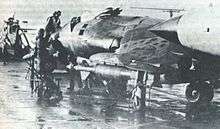
In 1982, six Harrier GR3 aircraft were taken down to the Falklands on SS Atlantic Conveyor,[22] and survived the Exocet attack, later to board HMS Hermes in May 1982. In June 1982, 12 GR3 aircraft were flown from Wittering, via RAF Ascension Island and mid-air refuelling with Victor tankers, on an 8,000 mile journey to the Falklands in 17 hours, which set an RAF record. The Harriers were from 1(F) Sqn. On 27 May 1982, Sqn Ldr (later Gp Capt) Bob Iveson was hit by anti-aircraft fire from GADA 601's 35mm cannon, and he ejected seconds before his aircraft exploded in mid-air near Goose Green. He evaded capture for two and a half days before being rescued by helicopter.
In January 1983, Sqn Ldr Brenda Palmer became the Senior Air Traffic Controller at the base, the first woman in the RAF to hold that title.
It was announced in December 2009 that RAF Wittering was to become the sole operational base for the RAF/RN Harriers of Joint Force Harrier after the announcement that RAF Cottesmore was to close. However, as a result of the 2010 Strategic Defence and Security Review, the Harrier fleet was withdrawn in December 2010[23] with all of Wittering's Harriers being stored at RAF Cottesmore. Towards the end of October 2010 parliament announced that the Harrier would be retired and on 15 December 2010 they were to fly over RAF Wittering amongst other RAF stations, from RAF Cottesmore. Due to the freezing conditions and low-cloud cover, the Wittering flypast could not take place.
Gliding
RAF Wittering is also the birthplace of the Royal Air Force Gliding & Soaring Association's Four Counties Gliding Club, originally set up in March 1955. Following several relocations, the club returned to Wittering in late 2005,the club closed in late 2014. The RAFGSA East-Midlands Gliding Club was also based at Wittering during the late 1970s and early 1980s.
RAF Regiment
From 1970 to 1983 the station was also home to No. 5 Wing RAF Regiment consisting of No.15 and No.51 Squadrons RAF Regiment. On 21 June 1982, the Queen visited the station, as part of celebrations of the RAF Regiment's 40th anniversary.
In October 2001 No.37 Squadron RAF Regiment arrived from RAF Bruggen in the Ground-based Air Defence role but was later disbanded in March 2006.
The station was home to No. 3 Squadron RAF Regiment - a field squadron - who moved to Wittering from RAF Aldergrove in 2006 after a 7-month tour in Iraq. 3 Sqn were part of No 1 Force Protection Wing, also based at Wittering, 1 FP Wing also consisted of No. 504 Squadron Royal Auxiliary Air Force based at nearby RAF Cottesmore before that Squadron relocated to RAF Wittering and was re-subordinated to No 85 (EL) Wing.
Station commanders
The Station Commander ordinarily holds the rank of Group Captain. The ranks shown below, where above Group Captain, indicates higher ranks the former station commanders achieved.
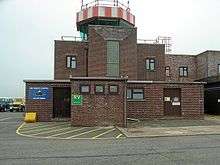

- Air Cdre Dudley Radford CB 1948
- AVM Sir Alan Boxer 1958-9
- Gp Capt Leonard Trent VC DFC 1959-62
- AVM John Lawrence CB 1962-4
- AVM Paul Mallorie CB 1964-9
- AVM Peter Williamson CB CBE DFC 1969-70
- AVM Alan Merriman CB CBE 1970-2
- Gp Capt IH Kepple 1972-
- Air Mshl Sir Laurence Jones 1975-6
- AVM David Brook CBE 1976-8
- Gp Capt AG Bridges MBE 1978-1981
- Gp Capt P King CBE 1981-1983
- AVM Peter Dodworth CB OBE March 1983- February 1985
- AVM Peter Millar CB February 1985- 1986
- AVM John Feesey 1986-8
- Gp Capt JH Thompson 1988-1990
- Gp Capt BS Morris 1990-1992
- Gp Capt PW Day AFC 1992-1995
- Gp Capt J Connolly 1995-7
- Air Chf Mshl Sir Christopher Moran 1997-9
- Gp Capt AFP Dezonie 1999-2001
- Gp Capt A Kirkpatrick 2001-3
- Gp Capt M Jenkins 2003-5
- Air Cdre Ashley Stevenson 2005 - November 2006
- Gp Capt Ro Atherton November 2006 - June 2008 (Wittering's first female commander)
- Gp Capt Paul Higgins June 2008 - December 2009
- AVM Richard Knighton December 2009 - June 2013
- Gp Capt Damian Alexander June 2013 - June 2015
- Gp Capt Richard Pratley June 2015 -
See also
References
- ↑ "Welcome to RAF Wittering". RAF. Retrieved 5 December 2013.
- ↑ "RAF - A4 Force". www.raf.mod.uk. Retrieved 2016-11-30.
- ↑ "MOD Better Defence Estate" (PDF).
- ↑ "First tranche of Army unit moves confirmed". Ministry of Defence. Retrieved 10 November 2011.
- ↑ "Flying Squadrons Return to RAF Wittering". raf.mod.uk/rafwittering. Royal Air Force Wittering. Retrieved 3 November 2015.
- ↑ "RAF - News by Date - RAF 38 Group Reforming Parade". www.raf.mod.uk. Retrieved 2016-11-30.
- ↑ Emma.Goodey (2015-11-04). "The Countess of Wessex". The Royal Family. Retrieved 2016-11-30.
- ↑ "Honorary Air Commodore Visits Wittering | Wittering View Online - RAF Wittering". www.witteringviewonline.co.uk. Retrieved 2016-11-30.
- ↑ "RAF Wittering Defence Aerodrome Manual" (PDF). 2015.
- ↑ "Low Flying Operations Squadron". raf.mod.uk. Retrieved 3 November 2015.
- ↑ "RAF - News by Date - Centennial 16 (Reserve) Squadron Arrives At RAF Wittering". www.raf.mod.uk. Retrieved 2016-11-30.
- ↑ "RAF - No 16 (Reserve) Squadron". www.raf.mod.uk. Retrieved 2016-11-30.
- ↑ "RAF - No 115 (Reserve) Squadron Central Flying School". www.raf.mod.uk. Retrieved 2016-11-30.
- ↑ "RAF - The University Air Squadrons". www.raf.mod.uk. Retrieved 2016-11-30.
- ↑ "RAF - News by Date - 6 Flying Training School". www.raf.mod.uk. Retrieved 2016-11-30.
- ↑ here, RAF Details. "RAF - No 5 Air Experience Flight". www.raf.mod.uk. Retrieved 2016-11-30.
- ↑ [email protected], The British Army,. "The British Army - 12 (Force Support) Engr Gp". www.army.mod.uk. Retrieved 2016-11-30.
- ↑ [email protected], The British Army,. "The British Army - 20 Works Group RE (Air Support)". www.army.mod.uk. Retrieved 2016-11-30.
- ↑ Mission Completed, Air Chief Marshal Sir Basil Embry, White Lion Publishers Limited 1976, ISBN 0-7274-0260-9, pages 205-208
- ↑ Mission Completed, Air Chief Marshal Sir Basil Embry, White Lion Publishers Limited 1976, ISBN 0-7274-0260-9, page 207
- ↑ "May 2001 crash". BBC News. 3 June 2001. Retrieved 7 July 2013.
- ↑ "1 Squadron in the Falklands". Raf.mod.uk. 2012-01-27. Retrieved 2013-07-07.
- ↑ "Last trip for one of Britain's iconic aircraft". BBC News. 2010-12-15. Retrieved 2010-12-15.
External links
| Wikimedia Commons has media related to RAF Wittering. |
- Official website
- Airport information for EGXT at World Aero Data. Data current as of October 2006.
- Four Counties Gliding Club website